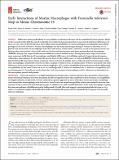Early Interactions of Murine Macrophages with Francisella tularensis Map to Mouse Chromosome 19
Author(s)
Fink, Avner; Hassan, Musa A.; Okan, Nihal A.; Sheffer, Michal; Camejo, Ana; Kasper, Dennis L.; Saeij, Jeroen; ... Show more Show less
DownloadFink-2016-Early Interactions o.pdf (4.218Mb)
OPEN_ACCESS_POLICY
Open Access Policy
Creative Commons Attribution-Noncommercial-Share Alike
Terms of use
Metadata
Show full item recordAbstract
Differences among individuals in susceptibility to infectious diseases can be modulated by host genetics. Much of the research in this field has aimed to identify loci within the host genome that are associated with these differences. In mice, A/J (AJ) and C57BL/6J (B6) mice show differential susceptibilities to various pathogens, including the intracellular pathogen Francisella tularensis. Because macrophages are the main initial target during F. tularensis infection, we explored early interactions of macrophages from these two mouse strains with F. tularensis as well as the genetic factors underlying these interactions. Our results indicate that bacterial interactions with bone marrow-derived macrophages (BMDMs) during early stages of infection are different in the AJ and B6 strains. During these early stages, bacteria are more numerous in B6 than in AJ macrophages and display differences in trafficking and early transcriptional response within these macrophages. To determine the genetic basis for these differences, we infected BMDMs isolated from recombinant inbred (RI) mice derived from reciprocal crosses between AJ and B6, and we followed early bacterial counts within these macrophages. Quantitative trait locus (QTL) analysis revealed a locus on chromosome 19 that is associated with early differences in bacterial counts in AJ versus B6 macrophages. QTL analysis of published data that measured the differential susceptibilities of the same RI mice to an in vivo challenge with F. tularensis confirmed the F. tularensis susceptibility QTL on chromosome 19. Overall, our results show that early interactions of macrophages with F. tularensis are dependent on the macrophage genetic background.
Date issued
2016-03Department
Massachusetts Institute of Technology. Department of BiologyJournal
mBio
Publisher
American Society for Microbiology
Citation
Fink, Avner, Musa A. Hassan, Nihal A. Okan, Michal Sheffer, Ana Camejo, Jeroen P. J. Saeij, and Dennis L. Kasper. “Early Interactions of Murine Macrophages with Francisella tularensis Map to Mouse Chromosome 19.” mBio 7, no. 2 (March 15, 2016): e02243–15.
Version: Final published version
ISSN
2150-7511